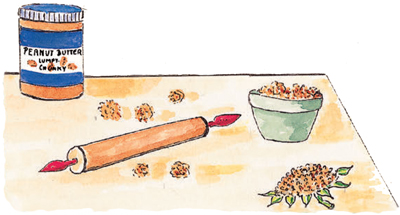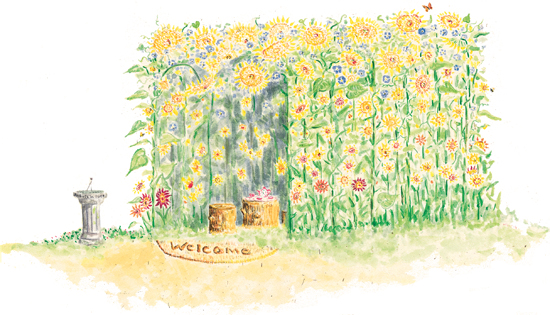
All Summer long, we hid and played in the sunflower house's dappled shade. A roof of morning glory vines twisted, tangled, intertwined. And close beside us, rusting leaves had conversations with the breeze.
You can design and grow your dream house with just a handful of sunflower and morning glory seeds, some sunny ground, and water. Shaggy green walls topped with gold and russet flowers will enclose the perfect playhouse for tea parties, picnics, or quiet moments together. The slender tendrils of morning glories will twine their way up the sunflower stalks and form a lacy roof. The best days will be when you lie inside your house and look up at the heavenly blue morning glory sky and giant sunflower faces smiling down on you.
Your Sunflower House will attract all kinds of visitors. Hummingbirds will zip in for a sip of nectar, and ladybugs will feast on pollen. Orange-and-black painted lady butterflies will land and deposit their eggs on the foliage.

Select a flat 10-by-10-foot area that gets at least six hours of sun daily and is sheltered from wind. Stand in the center of your plot at noon; the shadow you cast will point north. Using a stick, trace out a 6-by-9-foot rectangle in the ground; one of the shorter sides should face directly north.
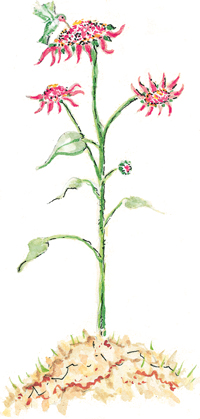
Following the outline, dig a narrow, 6-inch-deep planting trench. Prepare the trench for planting (see Preparing the Soil). Add well-aged manure or compost to the soil and fill in the trench. Cover the entire 10-by- 10-foot plot, except for the planting area, with a 3-inch layer of shredded bark or straw. This mulch will deter weed growth and provide a soft play area. The night before planting day, place the morning glory seeds in lukewarm water. By morning, their tough coats will soften so they will sprout.
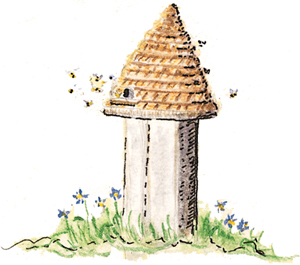
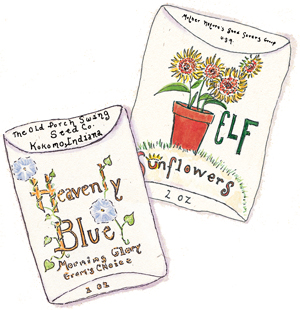
Begin planting when temperatures remain above 50°F. To mark the spots where you’ll plant seeds, drop small handfuls of flour a foot apart in the trench. Leave a 2-foot gap for the doorway on one of the short sides. Poke two 1-inch holes into the middle of each spot of flour. Drop a ‘Russian Mammoth’ sunflower seed into one of the holes; pop a morning glory seed into the other. Plant the rest of the sunflower seeds (the small and medium height) at 4-inch intervals between the big ones (see Planting Seeds).
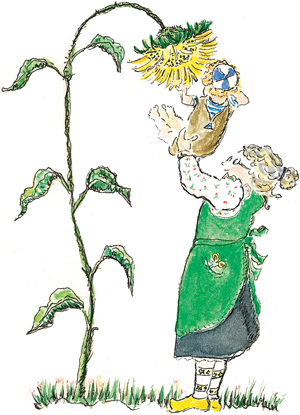
Newly sown seeds need to be kept moist to germinate. Water your garden daily with a gentle spray from a watering can. Feed your plants every two weeks with a half-strength blend of liquid kelp and fish emulsion. When your plants are about 4 inches high, give them a full-strength feeding every four weeks, and water when necessary (do the poke test with your finger to see if soil is dry).
Cutworms and slugs will have their eyes on the emerging giant sunflowers. To protect the delicate shoots, cut the bottom out of a paper cup and slip it over each plant and its morning glory neighbor. When the sunflowers are about 6 inches high, slit the cup and slip it off.
If necessary, sink sturdy stakes at least 12 inches into the soil to support the biggest sunflowers. Dead-head the small sunflowers, pinching or snipping at the node just below the worn-out blossom.
When the morning glories reach the top of the sunflower stalks, loosely tie a 7-foot-length of twine just below the head of the tallest sunflowers. Carry the lengths of twine across the rectangle and tie them carefully under the heads of the giant plants on the opposite side. The morning glories will creep across the twine to form the roof of your Sunflower House.

Your Sunflower House is your private hideaway through the dappled days of summer. Stock it with your favorite books and toys and keep your Explorer’s Kit nearby.

1. Their name is morning glory for a reason. Catch them opening their bright blue eyes about 5 A.M.
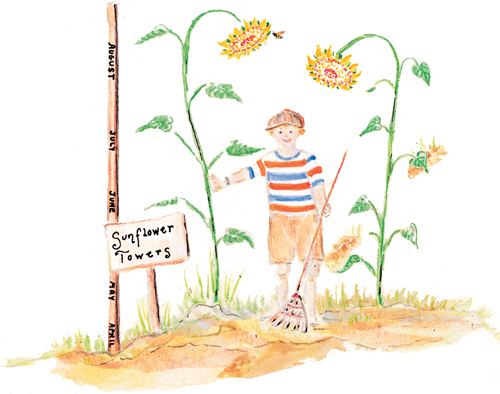
2. Measure a stalk of the ‘Russian mammoth’ sunflower every week and record the number of inches it grows.
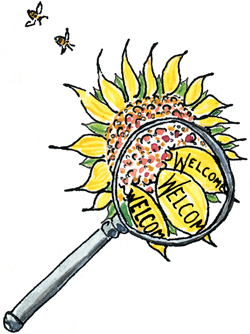
3. Use a magnifying glass to inspect a sunflower head. It consists of rays and disks. Like welcome banners, the rays entice insects to feed on and pollinate the disks.
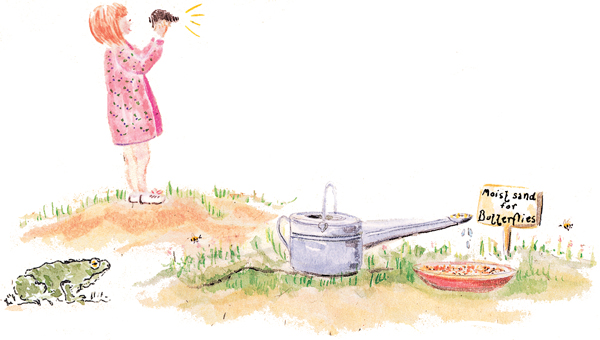
4. As your house grows, take turns standing inside, next to a sunflower, and photographing each other.
5. Do morning glory tendrils always twine in the same direction?
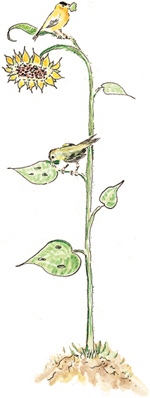
6. Sunflower leaves make delicious salads for hungry birds.
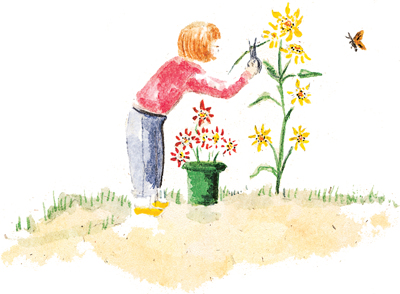
7. Cut lots of bouquets. More flowers will grow as you pick.
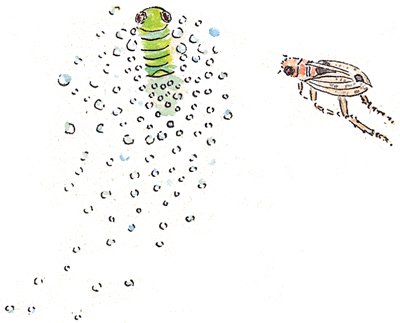
8. Go on a bug safari. Have you noticed foam on the sunflower leaves? This “frog spit” is where the froghopper nymph hides. Look closely at the bubbles and if you’re lucky, you’ll see the nymph’s tail pumping lather from its abdomen.

As autumn days shorten, frosts wither the leaves and vines of your Sunflower House. The tightly packed seeds begin to ripen, and forty-three species of birds, suck as cardinals, jays, and goldfinches, help themselves to the feast. When the backs of the flower heads turn golden brown, it’s time to cut and dry them. Pick a supply of seeds to nibble while you dream of next summer’s Sunflower House. Invite friends to share your harvest and do the following projects.

Some of the most active pollinators in the garden are peaceful dwarf carpenter bees, mason bees, and leaf cutters, which like to make their homes in the pithy stems of sunflowers. To make sure they have warm winter lodgings, nail a clean one-pound coffee can to a mounting board and stuff it with stalks. Attack the board to a sheltered spot on your house or an outbuilding.
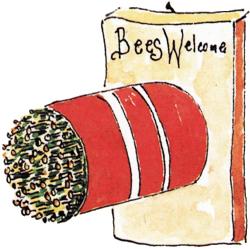

Lay freshly harvested giant sunflower heads faceup on a work surface. Cut and remove the center of the sunflower head. The remaining ring is the base for an autumn wreath. Using glue, attach a cluster of acorns, pods, nuts, or cones to the top of the ring. Let the wreath dry completely. Tie a length of raffia or ribbon around the top and hang.


In Nordic countries, people believe that sharing the crop with the birds on Christmas Eve ensures a bountiful crop and a year of good weather. To make a sunflower garland, poke a hole through the top of a dried sunflower head and string a wire through it. Using the wire, attach the flower head to a rope strung between trees or fence posts. Keep adding heads until the rope is full.
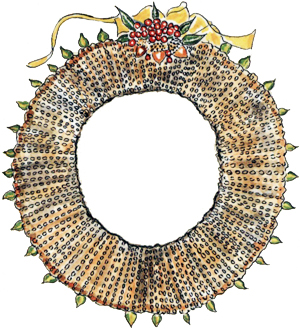
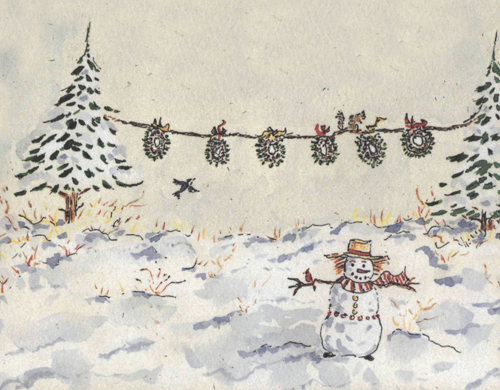

Preheat the oven to 200°F. Shake or pick out the ripe seeds from dried sunflower heads. Spread the seeds on an ungreased cookie sheet, and salt them lightly. Bake for 3 hours, stirring once each hour. Remove from the oven, and let cool. Pour the seeds into a covered container and store in a cool place. Whenever you’re hungry or tired, snack on your sunflower seeds for a high-protein energy boost.
Save some of your browned sunflower seeds and spread them on a work surface covered with a 12-inch sheet of waxed paper. Use a rolling pin or potato masher to crush the seeds into a coarse meal.
Pour the meal into a bowl, add 1 tablespoon of peanut butter, and mix together with a fork. Add more peanut butter until the mixture is firm. Roll into Ping—Pong-size balls. Wrap in waxed paper or plastic wrap and store in the refrigerator for snacking.
Be sure not to bake all the seeds so you can send your friends home with some, along with directions for growing their own Sunflower Houses next spring.
